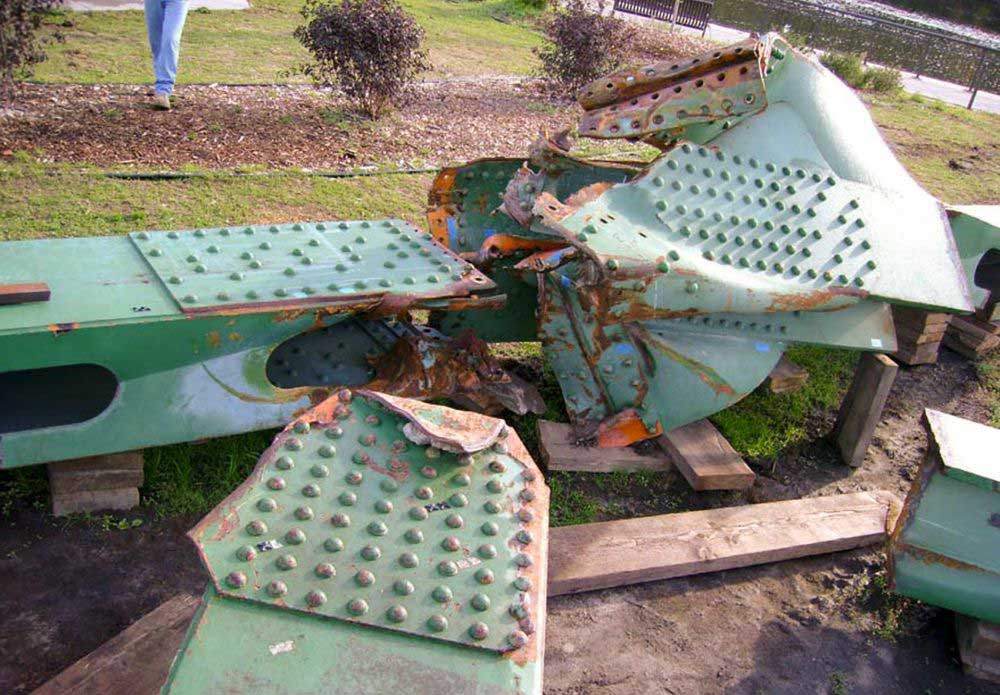‘When Good Bridges Go Bad’
Published 5:00 pm Thursday, May 29, 2014

- <p>Associated Press In this undated photo made available by the National Transportation Safety Board, debris from the Minneapolis freeway bridge that collapsed Aug. 1, 2008 shows a section of the steel-truss framework known as the U10 node from the bridge's west side in. The NTSB said in an update on its investigation Monday March 17, 2008, that the steel plates at this section, known as gussets, were too thin for the loads the bridge carried.</p>
After listening to Christopher Higgins talk about failed bridges for more than an hour, audience members needed some assurance Thursday that bridges on the North Coast can hold up to everyday use and potential disaster.
Higgins, a structural engineer and Oregon State University professor, could give no such comfort because he said each is uniquely different and would require actual analysis.
Vibration is not necessarily a bad thing, Higgins said, in response to worries about the Astoria Bridge, which was followed by some uneasy laughter. Ive never felt unsafe on that bridge.
Higgins makes a living stress-testing bridge material and designs in a laboratory at OSU. He and several graduate students do a job that can literally save lives.
For most of Higgins presentation the last installment of the 24th season of the Columbia Forum he showed pictures of bridges that have failed across the United States over the past century and the late 1800s.
The theme of Higgins talk was: When Good Bridges Go Bad. Higgins said, All bridge failures are bad. Most of them are preventable or predictable.
He said in all cases, engineers tend to learn from failures so that mistakes arent repeated. Most of the time, the initial design and construction result in good outcomes.
We dont worry about driving over that bridge, he said, generalizing about all bridges, so were pretty confident.
The main objective of bridge construction, he said, is balancing the strength of the structure with the forces that are applied, whether they are intended for truck and car use or flooding and erosion. We have to provide that balance.
Balancing the two proved difficult in the late 19th and early 20th centuries. Train bridges tended to be the most problematic and resulted in more than 80 deaths at times when they failed. Testing was inadequate and bridges were often made of wood, subject to decay and much more susceptible to natural forces.
Causes for failures
Sometimes vessels or vehicles can strike a bridge in a certain spot and cause a chain reaction affecting the structural integrity, which is what happened with the Interstate 5 Skagit River Bridge collapse in Washington. The construction phase can be the most uncontrollable, Higgins said.
Most of the time, the structure is most vulnerable when its not fully finished, he said. Once we get it fully assembled it tends to be a lot more robust. A lot of problems happen in construction, but you dont usually hear about them because theyre not open to the public.
Another reason for bridge failures is fatigue and fracturing of steel or concrete in the truss. Higgins gave the example of a paper clip that is bent back and forth until it breaks.
Strength for an engineer is safety, he said. Strength means it wont fall down.
Several failures have been instrumental in heightening safety and better design of bridges in the United States. In 1967, the Silver Bridge connecting Ohio and West Virginia fell apart, killing 46 people. A crack in a steel eyebar connection was the main culprit after deteriorating over time. The tragedy ushered in a national regulatory system for monitoring public bridges.
This is where they started the federal Bridge Inspection Program, Higgins said. Every two years, bridges on the federal system over a certain span length have to be inspected and evaluated to make sure you dont have that crack thats growing unforeseen.
Higgins said the inspection program is becoming even more modernized and specific.
But in 2007, 13 people lost their lives in Minneapolis when the Interstate 35W bridge across the Mississippi River failed. A bridge inspector failed to notice a steel plate bending in a 2003 evaluation. Over the same section of the bridge, crews stockpiled material for road maintenance in 2007 and likely caused the final failure of the bridge.
There should be no unsafe bridges in operation, said Higgins, however, he noted that bridges can be structurally deficient and still be safe.
Higgins revealed that there are 206 structurally deficient bridges in Oregon. In Clatsop County, a few bridges along U.S. Highway 26 are considered deficient.
You cant really go east or west, north or south in Oregon without crossing one or another of them, he said. Again, that doesnt mean theyre unsafe. Deficient can mean the bridges are too narrow or dont have enough clearance for modern transportation.
Patrick Corcoran, coastal natural hazards specialist with OSU Extension Service, asked Higgins to address the possibility of all North Coast bridges failing in the event of a Cascadia Subduction Zone earthquake, and whether residents could still walk over them.
What would your vision be of the remnants and its durability for pedestrians? he asked.
Youre asking an impossible question, Higgins said. In the end I cant answer anything specific. Its like asking me to diagnose a patient if I were a medical doctor. I would have to look at the individual bridge and the individual details. It can come down to even site specific characteristics of the soil.
Higgins was willing to say that the bridges in Oregon will not be able to withstand the kind of shaking experts predict will occur when the earthquake hits.
It will be a major disaster if Cascadia hits and we have not done the work to harden the infrastructure that is around us, he said.





